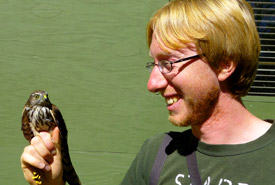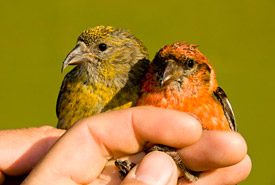Why I'm hooked on birding at the Tatlayoko Lake Bird Observatory

Avery Bartels with a sharp-shinned hawk (Photo by Kristie Foster)
Many years before I was born my parents bought eight acres (three hectares) with a small cabin on it near Nelson BC. As their family grew, so did their humble abode to accommodate my four siblings and me.
From as early as I can remember I have been drawn to nature. I remember being fascinated first with dinosaurs, then whales; but both had the distinct disadvantage of being rather difficult to find on our property. Finally I settled on birds, as they were readily available and seemed to come in enough shapes and sizes to keep my six-year-old attention span.
As I accumulated bird books and studied them with increasing obsessiveness it became clear that I would have to start travelling farther than the edge of our property if I was too see all the birds in my field guides. With my parents seemingly unwilling to head off to Florida or California or southern Ontario at my whim, I made do with summer camping trips to other parts of the province. That is, until I finished high school.
Costa Rica, Panama, Honduras and Australia were all ticked off in my first two winters of freedom. With my newfound mobility, my focus began expanding and in the fall of 2008 a new aspect of birding was introduced to me. As a volunteer at the Long Point Bird Observatory (LPBO) in Ontario I was introduced to birding for the sake of conservation; something that had never really occurred to me before. The challenge shifted from simply identifying birds to doing so within the confines of protocols, and on top of that, now I had to keep track of the numbers as well. I learned how to handle birds and to band them, which turned out to be perhaps the most important skill I picked up.
After two seasons of migration monitoring at Long Point I was offered a job at the Tatlayoko Lake Bird Observatory (TLBO), operated by the Nature Conservancy of Canada back in my home province. I had never heard of the Tatlayoko Valley before then but although I was only hired for half the season that first fall, in that short time I was hooked!

White-winged crossbills, Tatlayoko Lake Bird Observatory, British Columbia (Photo by Steve Ogle)
Since then I have been back for each of the subsequent four fall seasons. From the beginning of August, when the local fledgling song sparrows and yellow warblers are dispersing over the valley; through the late August push of warbling vireos that progresses into the dominance of Lincoln’s sparrows for the month of September; to the last hurrah of ruby-crowned kinglets, yellow-rumped warblers and orange-crowned warblers that mark the end of September and another season. With each year the patterns became more pronounced to me and the exceptions easier to pick out.
In 2014 TLBO became a full member station of the Canadian Migration Monitoring Network (CMMN). All the data we had collected at TLBO, along with that of each of the other 24 member stations across Canada, was submitted to the CMMN where it is used to provide nationwide assessments of bird populations and population dynamics. One such example is the 2012 State of Canada’s Birds, the foundation of which was provided by data from stations with 10 or more years of operation. TLBO is entering its 10th season so our data will be included in the next edition!
As we, as a species, have an ever-increasing impact on the ecosystems around us, the importance of these long-term monitoring efforts is growing every year.
This year, I'll be participating in the Great Canadian Birdathon (formerly Baillie Birdathon), which consists of doing a birding Big Day at some point in the month of May. During a 24-hour period in late May I will try to see or hear as many species as possible. The date will depend on the weather as I will try to hit peak migration, and the location will be back on my old stomping grounds at the Long Point Bird Observatory!


